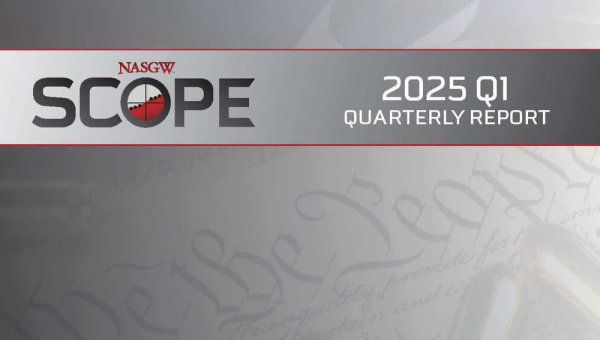

|
The National Association of Sporting Goods Wholesalers (NASGW) has released its Q1 2025 SCOPE Report, offering a comprehensive analysis of market performance and strategic guidance for shooting sports businesses across the U.S. While the report highlights year-over-year declines across major product categories, data reveals that the industry remains well ahead of pre-pandemic benchmarks, including 2019—the last normalized year before COVID-19 and global disruptions.
Following multiple years of elevated demand driven by pandemic conditions and geopolitical volatility, the market is entering a period of recalibration. Although overall firearms, ammunition, and optics shipments are down compared to Q1 2024, the Q1 2025 numbers exceed those of Q1 2019, signaling longer-term stability.
"While we are seeing some contraction compared to last year, it’s important to recognize that 2024 was inflated by short-term demand triggers—particularly the Israeli-Hamas conflict in Q4 2023,” said Tom Hopper, NASGW’s Senior Data Analyst. “This year’s data indicates a return to more sustainable market conditions."
Key Market Trends
1. Firearms Shipments Show Modest Contraction Across Most Categories
Segment Highlights:
Takeaway: The handgun segment remains relatively resilient and serves as a counterweight to sharper declines in MSRs and tactical shotguns.
2. Ammunition Shipments Experience Significant Pullback
Takeaway: Inventory buildup and slower turn rates are suppressing new orders. Retailers are encouraged to evaluate assortment quality and prioritize top-performing SKUs.
3. Optics Market Stabilizes Following Late 2024 Surge
Takeaway: The optics market is recalibrating after a strong finish to 2024. Distributors should avoid speculative overstocking and buy to trend.
Macroeconomic Pressures Influence Buying Behavior
1. Inflation and Tariffs
Rising inflation and an emerging trade war are driving conservative spending patterns. Consumers are increasingly cautious about large or discretionary purchases, including firearms and ammunition.
2. Shrinking Discretionary Income
Economic uncertainty and job market fluctuations are reducing the appetite for non-essential purchases.
3. Slower Retail Traffic and Conservative Inventory Strategy
Retailers are limiting restocking as in-store and online traffic slows. This shift underscores the need for data-driven replenishment strategies tied to regional sell-through performance.
Regional and Product Insights
In optics, rifle scopes and reflex sights maintain a majority of shipment value, while thermal optics may require continued innovation or marketing to sustain their recent growth.
Strategic Recommendations for 2025
1. Align Product Strategies with Regional Demand
Use SCOPE’s geographic data to tailor inventory by market. For example, bolt-action rifles may continue performing well in regions with strong hunting seasons.
2. Double Down on Proven SKUs
Top performers include:
3. Use Forecasting Tools to Stay Agile
Track 13-week shipping averages and adjust purchase cycles to align with real-time market behavior rather than historical seasonal expectations.
4. Emphasize Value Messaging in Consumer Marketing
With consumer confidence fluctuating, highlight value in pricing, reliability, and application (e.g., home defense, recreational shooting, hunting).
5. Optimize Inventory with WOS Metrics
High WOS in categories like rifle scopes, tactical shotguns, and MSRs signals oversupply. Delay reorders and focus on high-velocity SKUs.
Navigating the Road Ahead
The Q1 2025 SCOPE Report confirms that the shooting sports industry is not in decline—but in transition. Demand is stabilizing at levels that still exceed those of 2019, presenting opportunities for businesses that embrace agility, collaboration, and a strategic use of data.
"Now is the time to prepare, not panic," said Hopper. "Retailers, distributors, and manufacturers must work together to adapt. Data will be the difference between simply surviving and sustainably growing."
About NASGW
The National Association of Sporting Goods Wholesalers (NASGW) serves as the premier industry resource for shooting sports wholesalers, manufacturers, and industry professionals. Through SCOPE, NASGW delivers data-driven insights to support more informed business decisions across the distribution channel.
For more information about SCOPE, visit www.nasgwscope.org.